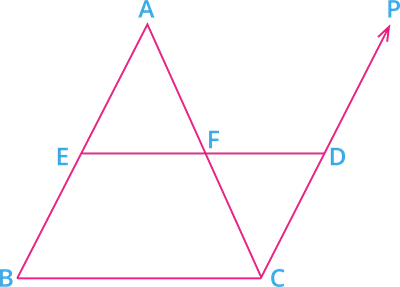UPSKILL MATH PLUS
Learn Mathematics through our AI based learning portal with the support of our Academic Experts!
Learn moreTheorem IX
The line segment joining the mid-points of two sides of a triangle is parallel to the third side.

Given: \(ABC\) is a triangle, where \(E\) is the mid-point of \(AB\) and \(F\) is the mid-point of \(AC\).
To prove: \(EF \ || \ BC\)
Construction: Draw a line segment through \(C\) parallel to \(AB\) and extend \(EF\) to meet this line at \(D\).
Proof: Since \(E\) is the mid-point of \(AB\), \(AE = EB\) - - - - (I)
Since \(F\) is the mid-point of \(AC\), \(AF = FC\) - - - - (II)
By construction \(AB \ || \ CD\).
\(\Rightarrow AE \ || \ CD\) and \(ED\) is a transversal.
\(\angle AEF = \angle CDF\) [alternate interior angles] - - - - - (III)
In \(\Delta AEF\) and \(\Delta CDF\):
\(\angle AFE = \angle CFD\) [vertically opposite angles]
\(\angle AEF = \angle CDF\) [(from (III)]
\(AF = FC\) [from (II)]
Therefore, \(\Delta AEF \cong \Delta CDF\) [by \(AAS\) congruence rule].
\(\Rightarrow AE = CD\) [by CPCT] - - - - - (IV)
From equations (I) and (IV), we can say that:
\(BE = CD\)
In quadrilateral \(EBCD\):
\(BE \ || \ CD\) and \(BE = CD\)
One pair of opposite side is equal and parallel.
Thus, \(EBCD\) is a parallelogram.
So, \(ED \ || \ BC\)
\(\Rightarrow EF \ || \ BC\)
Hence, proved.
Note: We proved that \(\Delta AEF \cong \Delta CDF\).
\(EF = FD\) [by CPCT]
[Since \(EBCD\) is a parallelogram, \(ED = BC\)].
Thus, we can conclude that the parallel mid-line segment is half of the third side of the triangle.
Important!
The line segment joining the mid-points of two sides of a triangle is parallel to the third side and is half of it.
Theorem X
The line drawn through the mid-point of one side of a triangle, parallel to another side bisects the third side.

Given: \(ABC\) is a triangle, where \(E\) is the mid-point of \(AB\). Also, \(EF \ || \ BC\).
Construction: Draw a line segment through \(C\) parallel to \(AB\) and extend \(EF\) to meet this line at \(D\).
To prove: \(F\) is the mid-point of \(AC\). That is, \(AF = FC\)
Proof: Since \(E\) is the mid-point of \(AB\), \(AE = EB\) - - - - (I)
In quadrilateral \(EBCD\):
\(EF \ || \ BC\) [since \(ED \ || \ BC\)]
\(EB \ || \ DC\) [by construction]
Both pairs of opposite sides are parallel.
Thus, \(EBCD\) is a parallelogram.
We know that "opposite sides of a parallelogram are equal".
\(EB = DC\) - - - - (II)
On comparing equation (I) and (II), we get, \(AE = DC\) - - - - (III).
Since \(AE \ || \ DC\) with transversal \(ED\) by construction.
\(\angle AEF = \angle CDF\) [alternate interior angles] - - - - (IV)
In \(\Delta AEF\) and \(\Delta CDF\):
\(\angle AEF = \angle CDF\) [from (IV)]
\(\angle AFE = \angle CFD\) [vertically opposite angles]
\(AE = DC\) [from (III)]
Therefore, \(\Delta AEF \cong \Delta CDF\) [by \(AAS\) congruence criterion].
\(\Rightarrow AF = CF\) [by CPCT]
Thus, \(F\) is the mid-point of \(AC\).
Hence, proved.